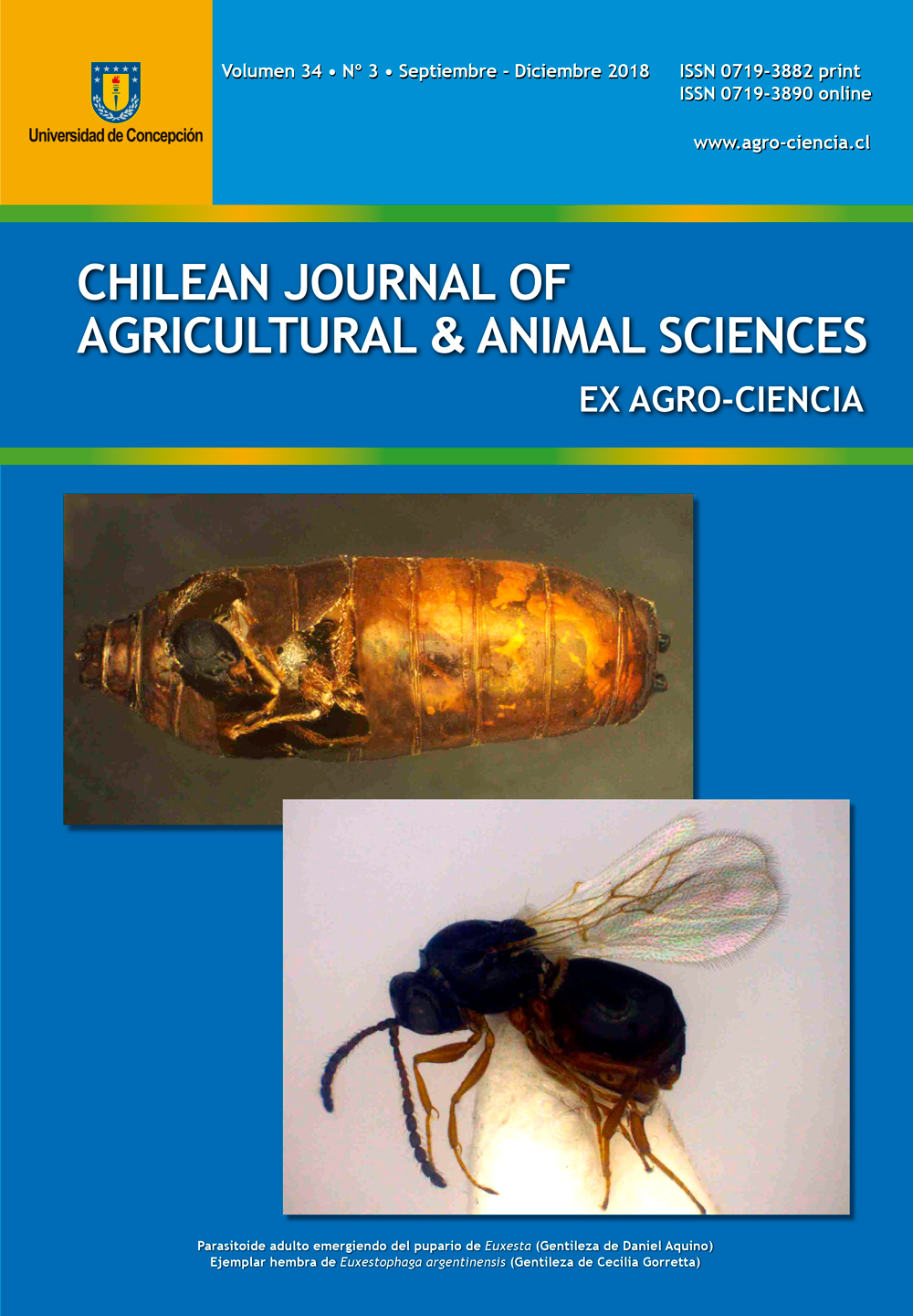Ver ítem
- xmlui.general.dspace_homeCentros Regionales y EEAsCentro Regional Buenos Aires SurEEA BalcarceArtículos científicosxmlui.ArtifactBrowser.ItemViewer.trail
- Inicio
- Centros Regionales y EEAs
- Centro Regional Buenos Aires Sur
- EEA Balcarce
- Artículos científicos
- Ver ítem
Tipologías y caracterización de sistemas de cría bovina de la Pampa deprimida
Resumen
La identificación y caracterización de los sistemas ganaderos permite acotar la diversidad y contribuir al proceso de toma de decisiones. Con el objetivo de identificar las tipologías de sistemas de cría bovina de la Pampa Deprimida se procesó la información de una encuesta de 115 predios utilizando 39 variables diagnósticas. Se analizaron datos de estructura de los establecimientos, indicadores productivos, recursos forrajeros y prácticas de alimentación
[ver mas...]
La identificación y caracterización de los sistemas ganaderos permite acotar la diversidad y contribuir al proceso de toma de decisiones. Con el objetivo de identificar las tipologías de sistemas de cría bovina de la Pampa Deprimida se procesó la información de una encuesta de 115 predios utilizando 39 variables diagnósticas. Se analizaron datos de estructura de los establecimientos, indicadores productivos, recursos forrajeros y prácticas de alimentación animal, reproducción, prácticas sanitarias e información social. A partir de un análisis de conglomerados se establecieron cuatro grupos: G1: Productor tecnificado de escala media; G2: Productor tradicional de escala media; G3: Empresa tecnificada local de escala grande; y G4: Empresa tecnificada de escala grande. La carga animal media fue 0,72 vaca equivalente ha-1. Los sistemas tecnificados presentaron mejores indicadores productivos que el tradicional. El principal recurso forrajero fue el campo natural, con mayor proporción en tradicionales (98%) que en tecnificados (67-72%). En éstos últimos la dieta también incluyó pasturas cultivadas (9-19%), verdeos de invierno (8,2-8,9%) y de verano (4,7-5,5%). Los tecnificados difirieron principalmente en escala (P < 0,05) (499 a 1627 ha), persona jurídica del propietario y la cercanía del lugar de residencia del titular y familia (urbana cercana o lejana según los grupos) entre otros, el reclutamiento de personal contratado temporariamente (75 a > 92%), el uso y frecuencia de consultoría profesional, y prácticas aplicadas de salud animal, entre otros. Las tipologías obtenidas pueden contribuir al diseño de propuestas específicas de transferencia tecnológica por instituciones del sector.
Identification and characterization of livestock systems help improve decision-making. In order to identify the typology of cow-calf systems from the Flooding Pampas, survey data of 115 farms were processed using 39 diagnostic variables. Data on farm structure, productivity indicators, forage resources, animal feeding practices, reproduction, animal health practices, and social information were analyzed. A cluster analysis was used to establish farm typologies. Four farm groups (G) were differentiated using cluster analysis: G1: Medium-scale technified farmer; G2: Medium-scale traditional farmer; G3: Large-scale technified local enterprise; and G4: Large-scale technified 4
enterprise. Overall mean stocking rate was 0.72 cow unit ha-1. The technified systems had better productivity indicators than the traditional systems. The main fodder resource was grasslands, accounting for 98% and 67-72% of traditional (98%) and technified (67-72%) systems, respectively. The diet in technified systems also included cultivated pastures (9-19%), and winter (8.2-8.9%) and summer fodder crops (4.7-5.5%). The technified systems mainly differed in terms of scale (P < 0.05) (499 to 1627 ha), legal ownership, farmer’s or farmer’s family’s place of residence (farm distance depending on G), recruitment of temporary staff (75 to > 92%), use and frequency of agricultural consultancy, adoption of different animal management practices, among others. This livestock farm typology may help agricultural institutions design specific technology transfer proposals
[Cerrar]
Identification and characterization of livestock systems help improve decision-making. In order to identify the typology of cow-calf systems from the Flooding Pampas, survey data of 115 farms were processed using 39 diagnostic variables. Data on farm structure, productivity indicators, forage resources, animal feeding practices, reproduction, animal health practices, and social information were analyzed. A cluster analysis was used to establish farm
[ver mas...]
Identification and characterization of livestock systems help improve decision-making. In order to identify the typology of cow-calf systems from the Flooding Pampas, survey data of 115 farms were processed using 39 diagnostic variables. Data on farm structure, productivity indicators, forage resources, animal feeding practices, reproduction, animal health practices, and social information were analyzed. A cluster analysis was used to establish farm typologies. Four farm groups (G) were differentiated using cluster analysis: G1: Medium-scale technified farmer; G2: Medium-scale traditional farmer; G3: Large-scale technified local enterprise; and G4: Large-scale technified enterprise. Overall mean stocking rate was 0.72 cow unit ha-1. The technified systems had better productivity indicators than the traditional systems. The main fodder resource was grasslands, accounting for 98% and 67-72% of traditional (98%) and technified (67-72%) systems, respectively. The diet in technified systems also included cultivated pastures (9-19%), and winter (8.2-8.9%) and summer fodder crops (4.7-5.5%). The technified systems mainly differed in terms of scale (P < 0.05) (499 to 1627 ha), legal ownership, farmer’s or farmer’s family’s place of residence (farm distance depending on G), recruitment of temporary staff (75 to > 92%), use and frequency of agricultural consultancy, adoption of different animal management practices, among others. This livestock farm typology may help agricultural institutions design specific technology transfer proposals
[Cerrar]

Fuente
Chilean Journal of Agricultural & Animal Sciences 35 (1) : 3-13. (2019)
Fecha
2019
Editorial
Universidad de Concepción. Facultad de Agronomía, Facultad de Ingeniería Agrícola y Facultad de Ciencias Veterinarias, Chile
ISSN
0719-3882
0719-3890
0719-3890
Formato
pdf
Tipo de documento
artículo
Palabras Claves
Derechos de acceso
Abierto
 Excepto donde se diga explicitamente, este item se publica bajo la siguiente descripción: Creative Commons Attribution-NonCommercial-ShareAlike 2.5 Unported (CC BY-NC-SA 2.5)
Excepto donde se diga explicitamente, este item se publica bajo la siguiente descripción: Creative Commons Attribution-NonCommercial-ShareAlike 2.5 Unported (CC BY-NC-SA 2.5)


